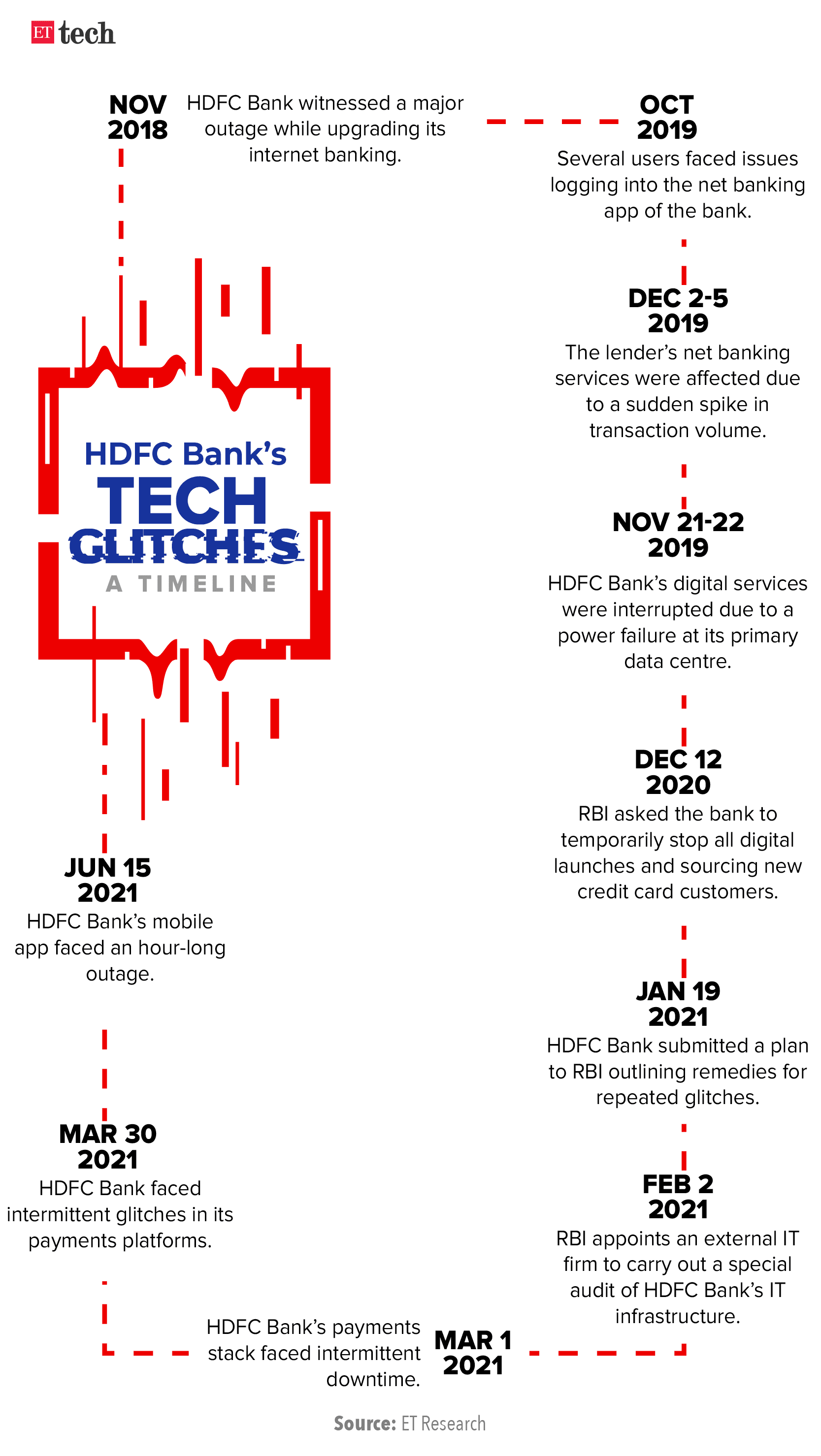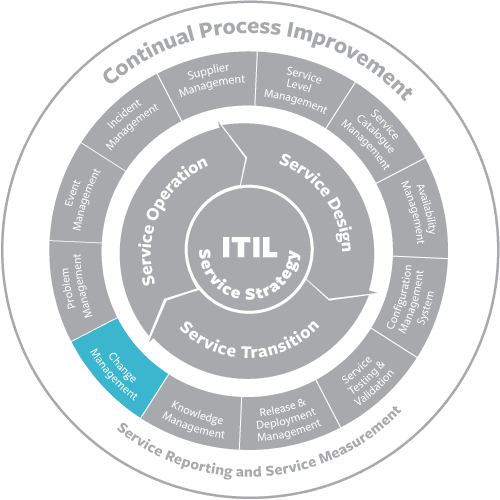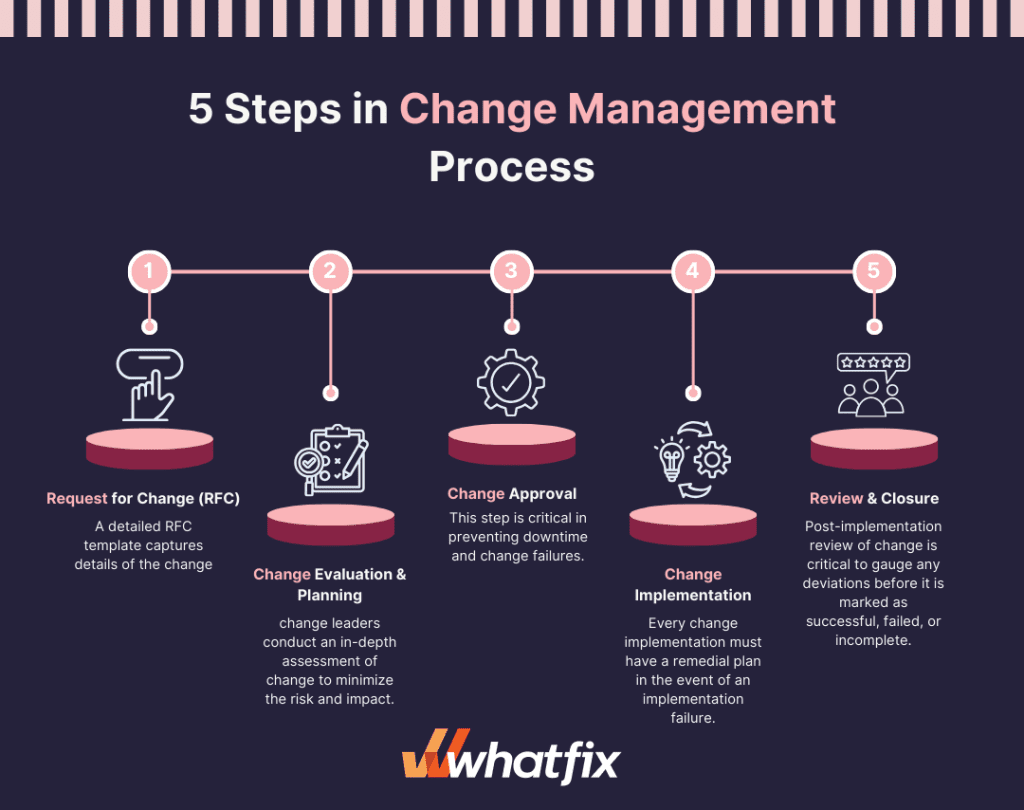
Organizations across industries are undergoing digital transformation to keep up with evolving customer expectations and needs. IT departments must keep pace with these continuous changes to tackle business challenges, reduce incidents, and stay relevant in their industry.
The consequences of poor change management are devastating for organizations. For example, India’s largest private-sector bank HDFC Bank Limited attempted to upgrade its digital banking app but faced constant customer backlash due to its poor change communication, lack of customer support, and subpar IT infrastructure.
Reserve Bank of India had to intervene in this situation, forcing the company to pull the plug on its digital launch as well as stop issuing new credit cards altogether. This not only caused the digital banking platform project to fail but effectively ground the company’s key services to a halt while it solved its large IT-related issues caused by poor project planning.

In this article, we discuss the concept of IT change management and how ITIL plays a crucial role in supporting digital transformation projects like the HFDC Bank example above. We’ll also provide an in-depth overview of IT change managemnet, and showcase specific use cases.
What Is IT Change Management?
IT change management is designed to minimize disruption of IT services, enable end-users, and drive adoption for IT and technology related change initiatives like implementing a new system, update a software application, or launching a new IT-related process.
This systematic approach by ITIL helps businesses manage risk management, establish cost-effective practices, strengthen customer relations, and create a stable IT environment that allows for growth, scalability, and effective change management.

Types of IT Change Management
Depending on the risk and impact, ITL categorizes change projects into the following four groups, each with different process flows:
1. Standard Change
Standard changes are periodical, low-risk and low-impact changes that follow a standard operating procedure. These changes require initial approval and do not require ITIL Change Advisory Board (CAB) approval every time—for example, OS upgrades and patch deployments.
2. Major Change
Changes such as data migration and new software implementation have high impact and high risk. These changes need both management and CAB approval. These changes involve a detailed proposal including cost-benefit, risk-impact analysis, and financial implications.
Change management tools such as digital adoption platforms support implementing such changes. Digital adoption platforms decrease the number of support tickets by providing contextual in-app guidance and on-demand training to its end-users.
3. Minor Change
Changes such as website updates are non-trivial, low-risk, low-impact changes with a potential to get transformed into standard changes over time.
4. Emergency Change
Emergency changes are unexpected disruptions such as security breaches or server outages that need to be resolved on priority. Emergency changes handle the change request retrospectively, post-implementation, and require immediate approval to minimize the impact. It’s crucial to review the implementation and document it to prepare for potential future risks.
Define the Change Management Process Flow
Successful ITIL change implementation requires an effective process flow to ensure the validation & testing of change before the deployment phase. The ITIL change management process flow consists of the following steps:

1. Request for Change (RFC)
The first step is initiating a change based on any incident, user request, or existing problem. A detailed RFC template captures details of the change, such as the need for change, impact, implementation timelines, and cost-benefit analysis.
2. Change Evaluation & Planning
In the second step, change leaders conduct an in-depth assessment of change to minimize the risk and impact. They determine the change type and priority, work on scheduling, roll-out, and back-out plan in case of any setbacks.
3. Change Approval
This step is critical in preventing downtime and change failures. For the required approval, a Change Advisory Board is formed to get the opinion of key stakeholders. This step is critical in preventing downtime and change failures. The Approval process and workflow vary according to the change type and priority.
4. Change Implementation
The change request then moves to the release and deployment team to coordinate with the appropriate technical and management teams to build, test, and implement the change. Every change implementation must have a remedial plan in the event of an implementation failure, as a failed change initiative often results in a colossal expense and risk exposure for an organization.
5. Review & Closure
Post-implementation review of change is critical to gauge any deviations before it is marked as successful, failed, or incomplete.
Roles & Responsibilities of Change Practitioners
Before initiating the process flow, change leaders must clearly define and assign the following roles & responsibilities.
1. Change Initiator
The change initiator identifies the need for change and initiates the RFC process. Support service staff and customer service personnel are best suited for this role due to their interaction with the system and customers.
2. Change Agent
A change agent acts as a catalyst for the change management process and helps an organization transform its operations by inspiring and influencing others. A change agent will promote, champion, enable and support an organization’s change implementation.
3. Change Leader
Change leaders command, influence, and advocate for long-term transformation initiatives. They must engage with the change rather than imposing the change.
For IT-specific change projects, these project leaders should have the ITIL knowledge and skills to lead and influence the initiative properly. Consider upskilling your IT change leaders with ITIL foundation certifications and training programs to enable them with the skills to efficiently lead change projects.
4. Change Advisory Board (CAB)
The change advisory board authorizes change by evaluating change requests and the associated risks. The board considers the change’s impact on all the stakeholders and issues recommendations to minimize the disruptions.
5. Change Approver
The change approver decides the fate of any change initiative by approving or rejecting a change request.
To establish role clarity from the beginning, consider using a RACI matrix to create employee accountability and understand potential factors that push against the success of a potential change.
Benefits of the ITIL Change Management Process
Sudden and unplanned changes disrupt IT services of an organization and reduce overall productivity. ITIL change management helps create a change initiative that is well-structured, thereby minimizing risks.
The benefits provided by an ITIL change management process include:
- Organizations manage change effectively by leveraging service desk tools to complete the RFC process and set up a robust workflow mechanism.
- Fewer service disruptions and IT incidents
- Better change communication on downtime and service unavailability due to scheduled changes.
- Ensure continuous process improvement to keep pace with industry trends
Limitations of the ITIL Change Management Process
Although ITIL change management offers several key benefits, there are a few limitations of this framework as well:
- The ITIL framework has a narrow scope of work and can’t be extended beyond IT changes.
- The ITIL framework has room for subjectivity, and if implemented incorrectly it can prove to be overly complex and expensive.
- If ITIL is a requirement and results in process improvements, onboarding third parties for IT changes to support future change often results in an increase in resistance to change.
Major Use Cases for ITIL Change Management
IT and DevOps teams routinely use ITIL change management to handle new change requests and deployment plans. A few critical use cases include:
1. Security
Security breaches are costly if not fixed in a timely matter. These emergency changes often only implement the critical components of change management processes due to associated time constraints and the need to get a fix live ASAP.
Organizations must expedite the process as live environments, and production systems become vulnerable during such changes. Standard testing, IT governance, and Emergency CAB (ECAB) approval are essential to prevent unintended disruptions.
2. Business Continuity
Every IT department must have a documented ‘Business Continuity and Disaster Recovery Policy’ for ensuring seamless operations and managing high-risk, high-impact changes. A business continuity plan empowers organizations to deliver services even in the event of disruptions. It includes clearly defined SLAs, resource optimization, and impact analysis.
For example, under the ISO 22301:2019 standard policy, organizations must state their business continuity objectives, the minimum levels of product and service operations considered acceptable, and the maximum tolerable period of disruption (MTPD) allowed.
3. Cloud Change Management
An increasing number of businesses are moving towards cloud computing, making cloud change management a standard change with a pre-approved process. Frequent releases in the cloud environment require an effective change management process. Organizations must use a sandbox environment for frequent QA and testing to ensure desired configurations and requirements.
Schedule a demo with our experts to discover how Whatfix can help you roll changes effortlessly.
Request a demo to see how Whatfix empowers organizations to improve end-user adoption and provide on-demand customer support
Thank you for subscribing!
Thank you for subscribing!



